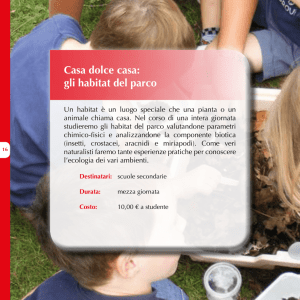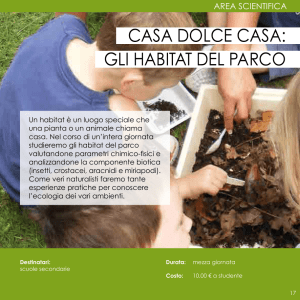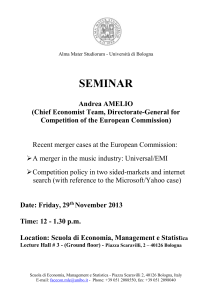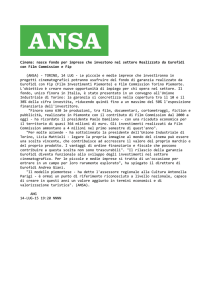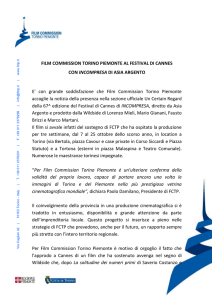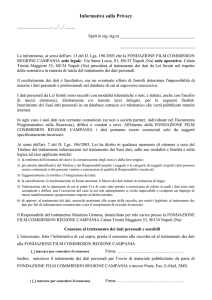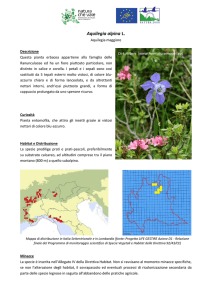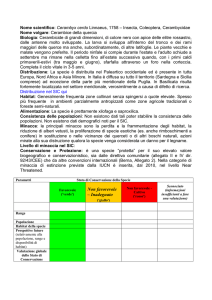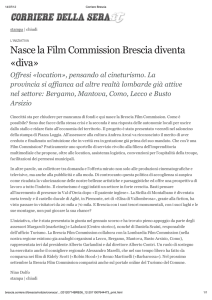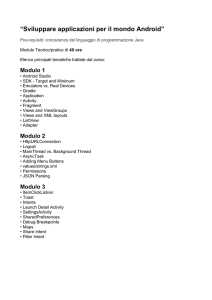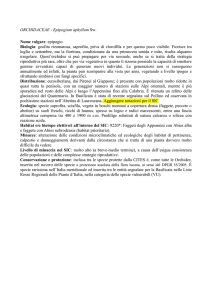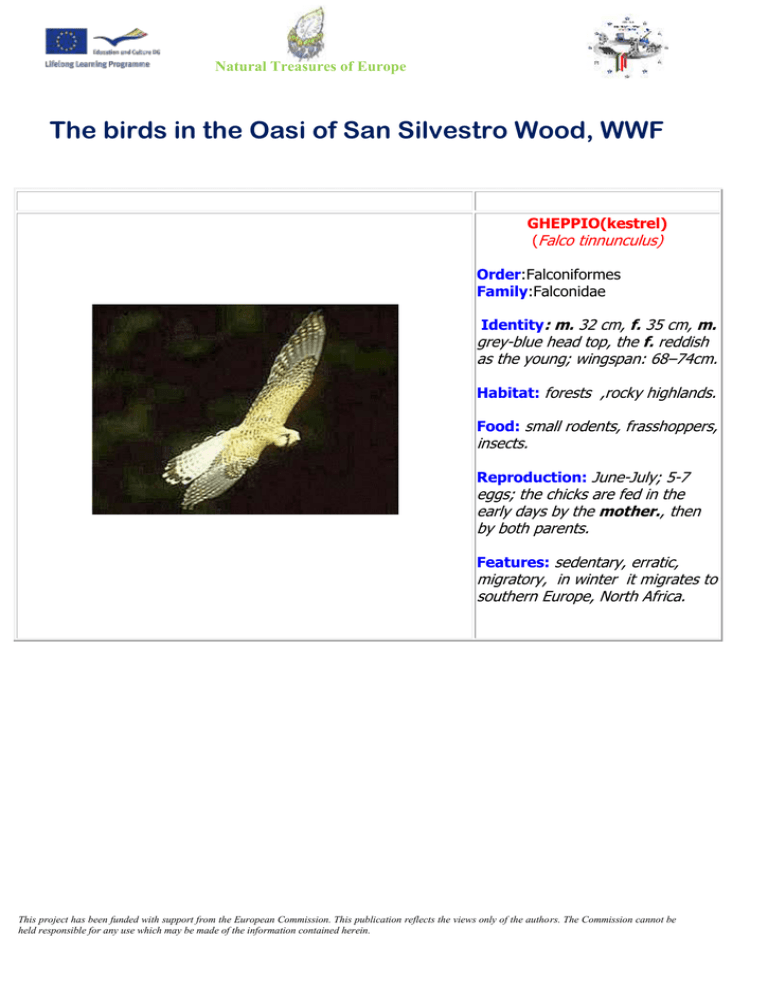
ITI - LS
Natural Treasures of Europe
The birds in the Oasi of San Silvestro Wood, WWF
GHEPPIO(kestrel)
(Falco tinnunculus)
Order:Falconiformes
Family:Falconidae
Identity: m. 32 cm, f. 35 cm, m.
grey-blue head top, the f. reddish
as the young; wingspan: 68–74cm.
Habitat: forests ,rocky highlands.
Food: small rodents, frasshoppers,
insects.
Reproduction: June-July; 5-7
eggs; the chicks are fed in the
early days by the mother., then
by both parents.
Features: sedentary, erratic,
migratory, in winter it migrates to
southern Europe, North Africa.
This project has been funded with support from the European Commission. This publication reflects the views only of the authors. The Commission cannot be
held responsible for any use which may be made of the information contained herein.
ITI - LS
Natural Treasures of Europe
POIANA(BUZZARD)
(Buteo buteo)
Order: Accipitriformes
Family: Accipitridae
Identity: f.bigger than 1 m.;
wingspan up to 1,5 m; brown
feathers with light spots on the
breast
Habitat: mountains and woody
places
Food :Snakes , mice, arvicole and
other small mammals
Reproduction: 2-4 eggs which
open at the beginning of
summer
Features: daily predator , it is
often mistaken for an eagle
because of the color of its
feathers; VOICE: characteristic
lament
This project has been funded with support from the European Commission. This publication reflects the views only of the authors. The Commission cannot be
held responsible for any use which may be made of the information contained herein.
ITI - LS
Natural Treasures of Europe
SPARVIERO
(Accipiter nisus)
Oder: Accipitriformes
Family: Accipitridae
Identity: length 28-38 cm; wing
span up to 80 cm.
Habitat: Coniferous , forests
Food: small mammals , birds and
insects
Reproduction: Nest on the
coniferous with dry branches ; it
broods 4-6 eggs for 33 days; the
male gets food both for the female
and the chicks .
Features: daily predator as big
as a pigeon; to capture its prey it
uses its big claws while it uses its
beak to take the flesh off the
captured animals
This project has been funded with support from the European Commission. This publication reflects the views only of the authors. The Commission cannot be
held responsible for any use which may be made of the information contained herein.
ITI - LS
Natural Treasures of Europe
GUFO COMUNE
(Asio otus)
Order:
Strigiformes
Family: Strigidae
Identity: Height 70 cm; wingspan
as far as 1,5 m; brown grey
coloured with white and black
striping; it has long tufts of feathers
on its head , coloured yellow
orange eyes .
Habitat: forests
.
Food: small mammals, roditors
and birds, beetles and frogs .
Reproduction: it has no real nest,
it lays its eggs on the soil or in the
other old bird nests at the
beginning of summer time max 2
chicks a year
Features: nightly raptor it blows up
its feathers when it is attacted and
so it looks bigger.
f
This project has been funded with support from the European Commission. This publication reflects the views only of the authors. The Commission cannot be
held responsible for any use which may be made of the information contained herein.
ITI - LS
Natural Treasures of Europe
BARBAGGIANNI
(Tyto alba)
Order: Strigiformes
Family: Strigidae
Identity: typical heart –shaped
face , height 38 cm ; male and
female of the same color
Habitat: it likes to live in places
with human beings .
Food: mice, bats, sparrows,
amphibians .
Reproduction: 4-6 eggs from
March to November usually laid on
the soil , it is able to lay eggs even
three times a year ; females are
fed by the male for all the period
of the brood .
Features: wavy flight, sedentary ,
hoarse voice with a often repeated
sound.
This project has been funded with support from the European Commission. This publication reflects the views only of the authors. The Commission cannot be
held responsible for any use which may be made of the information contained herein.
ITI - LS
Natural Treasures of Europe
CIVETTA
(Athene noctua)
Order:Strigiformes
Family: Strigidae
Identity: m. and f. same colour;
length 23 cm; wing span 50 cm,
as big as a black bird .
Habitat: parks ,woods ,open
spaces and stony places
Food: during the night above all
mice , during the evening above all
insects for this reason it is useful.
Reproduction: it builds its nest in
the trees holes, or among the
stones ; it lays 4-8 eggs; it broods
for 26- 28 days; youngs are able
to flight for 28-35 days .
Features: nightly raptor , above
all sedentary, some of them fly
away their territory as far as 200
km.
This project has been funded with support from the European Commission. This publication reflects the views only of the authors. The Commission cannot be
held responsible for any use which may be made of the information contained herein.
ITI - LS
Natural Treasures of Europe
ALLOCCO
(Strix aluco)
Order:Strigiformes
Family: Strigidae
Identity: lenght 38 cm; wing
span 92-94 cm; m. and f. of the
same colour
Habitat: forests ,woods, parks
with old trees; it camouflages very
well among the vegetation.
Food: bats, snackes, amphibians
and insects .
Reproduction: white eggs; it lays
eggs in the trees- holes; 3-5 eggs
for 20- 30 days.
Features:nightly raptor,
sedentary,it has an eccellent sight
also because it is able to turn its
head of 270
This project has been funded with support from the European Commission. This publication reflects the views only of the authors. The Commission cannot be
held responsible for any use which may be made of the information contained herein.
ITI - LS
Natural Treasures of Europe
BALLERINA GIALLA
(Motacilla cinerea)
Order:Passeriformes
Family:Motacillidae
Identity: Yellow back , with
shades on the tail, slim.
Habitat:more comon on the
mountain rather than on the plain
Food.Invertebrates, larvae ,
coleoptera
Reproduction: It nests either in
the thick vegetation on the banks
or in the walls among rocks .
Features: It winters in our places,
but it also settles; it has a special
flight, just like the white wagtail
(ballerina Bianca ) one .
This project has been funded with support from the European Commission. This publication reflects the views only of the authors. The Commission cannot be
held responsible for any use which may be made of the information contained herein.
ITI - LS
Natural Treasures of Europe
BALLERINA BIANCA
(Motacilla alba)
Ordine:Passeriformes
Famiglia:Motacillidae
Identità: 17 cm; disegno netto
bianco e nero con zampe slanciate
e coda lunga.
Habitat: Più comune in montagna
che in pianura giardini, fattorie,
campagna aperta e città.
Alimentazione: Invertebrati,
larve e coleotteri.
dRiproduzione: Nidifica nei buchi
dei fabbricati, rocce ecc..
Caratteristiche: Svernante da
noi, ma anche stanziale; ha un
volo “a festoni”, il canto ha un trillo
che contiene varianti della nota di
richiamo.
This project has been funded with support from the European Commission. This publication reflects the views only of the authors. The Commission cannot be
held responsible for any use which may be made of the information contained herein.
ITI - LS
Natural Treasures of Europe
LUI’
(Nucifraga
caryocatactes)
Ordine:Passeriformes
Famiglia:Sylvidae
Identità: Piccolo uccello di 10 cm.
Habitat: Boschi, giardini, fattorie,
campagna aperta e città.
Alimentazione: Insetti, larve e
ragni.
Riproduzione: Il nido viene
costruito a terra ed il maschio varie
volte ne costruisce alcuni falsi per
ingannare i predatori;10 uova che
vengono covate da entrambi i
genitori, che provvedono anche al
nutrimento dei piccoli.
Caratteristiche: utilizza il becco
lungo per procurarsi il cibo sotto la
corteccia degli alberi.
CAPINERA
(Sylvia atricapilla)
Ordine:Passeriformes
Famiglia:Sylvidae
Identità: Piccolo uccello 14 cm,
piumaggio grigio nero; il m. ha la
parte superiore della testa nerolucida.
Habitat: Siepi fitte, cespugli e
giardini.
Alimentazione: Insetti, bacche,
larve e ragni.
Riproduzione: Nidifica vicino al
terreno, preferibilmente nei
cespugli di bacche; covano
entrambi i genitori; 4-6 uova; i pulli
snidano a meno di 2 settimane
This project has been funded with support from the European Commission. This publication reflects the views only of the authors. The Commission cannot be
held responsible for any use which may be made of the information contained herein.
ITI - LS
Natural Treasures of Europe
dalla nascita.
Caratteristiche: Migratrice
parziale.
LUCHERINO
(Carduelis spinus)
Ordine:Passeriformes
Famiglia:Sylvidae
Identità: piccolo uccello con il
piumaggio sul petto e sul collo
sfumato di giallo.
Habitat: Boschi conifere e betulle.
Alimentazione: Soprattutto insetti,
semi.
Riproduzione: Nido in alto sulle
conifere; uova 4-5 azzurre
punteggiate di bruno; nidiate 2;
cova12 gg.
Caratteristiche: Migratore
regolare e svernante, raro come
nidificante.
FRINGUELLO
(Fringilla coelebs)
Ordine:Passeriformes
Famiglia:Fringillidae
Identità: Il m. in periodo
riproduttivo è facilmente
riconoscibile per l’abrasione delle
punte delle penne del capo; doppia
barra alare bianca.
Habitat: Boschi montani e
collinari, parchi e giardini, siepi.
Alimentazione: Semi, cereali,
invertebrati
Riproduzione: Primavera –
estate; 4-5 uova; nidiate 1; cova
This project has been funded with support from the European Commission. This publication reflects the views only of the authors. The Commission cannot be
held responsible for any use which may be made of the information contained herein.
ITI - LS
Natural Treasures of Europe
12-13 gg.
Caratteristiche: Comportamento
gregario durante il periodo
riproduttivo; sedentario, migratore
e svernante
CARDELLINO
(Carduelis carduelis)
Ordine:Passeriformes
Famiglia:Fringillidae
Identità: Facilmente riconoscibile
per i capo diviso in tre bande,
colorate di rosso, bianco e nero e
per la banda alare gialla.
Habitat: Boschi, campagne, dove
nidifica in piccole colonie all’interno
di siepi e frutteti
Alimentazione: Semi di cardo e di
altre piante, insetti.
Riproduzione: la sola f. costruisce
il nido verso fine aprile; 3-6
uova;cova 12-15 gg. Anche più
nidiate all’anno.
Caratteristiche: Si sposta in
piccoli gruppi i cui individui si
mantengono in contatto con
continui richiami.
This project has been funded with support from the European Commission. This publication reflects the views only of the authors. The Commission cannot be
held responsible for any use which may be made of the information contained herein.
ITI - LS
Natural Treasures of Europe
AVERLA PICCOLA
(Lanius collurio)
Ordine:Passeriformes
Famiglia:Lanidi
Identità: m. presenta una
maschera nera intorno all’occhio,
ali rossicce; le f. hanno colori più
smorti.
Habitat: Aree aperte
inframmezzate da cespugli e siepi
fino a quote elevate.
Alimentazione: Insetti, topi, anfibi,
lucertole.
Riproduzione: Depone una sola
covata all’anno; cova la f. mentre il
m. fornisce il cibo; covata 15 gg.
Abbandono del nido 13-16 gg
dopo la schiusa delle uova.
Caratteristiche: Nidifica in tutta
Italia, tranne che in Sicilia dove è
sostituita dall’Averla capirossa
(Lanius senator); sverna a Sud del
Sahara.
RIGOGOLO
(Oriolus oriolus)
Ordine:Passeriformes
Famiglia: Oriolidae
Identità: di solito colorati molto
vivacemente; dimensioni di uno
stormo; m. inconfondibile giallo
con ali e coda neri.
Habitat: Boschi fitti collinari e
pioppeti in pianura
Alimentazione: Insetti e ragni,
frutti.
Riproduzione: nido sospeso ad
una forcella all’estremità di un
ramo; uova 3-4; nidiata 1; cova 14This project has been funded with support from the European Commission. This publication reflects the views only of the authors. The Commission cannot be
held responsible for any use which may be made of the information contained herein.
ITI - LS
Natural Treasures of Europe
15 gg.
Caratteristiche: Canto molto
caratteristico, melodico e flautato,
si sente da lontano.
USIGNOLO
(Luscinia
megarhynchos)
Ordine:Passeriformes
Famiglia: Turdidae
Identità: Lungo 16-17 cm, ha
piumaggio grigio ruggine o bruno
sulla parte superiore, più chiaro su
quella inferiore; la coda è rossobruna. Sua caratteristica sono i
grandi occhi mobilissimi
Habitat: Margini di aree boschive
con fitto sottobosco, sia
pianeggianti che collinari.
Alimentazione: Durante il periodo
riproduttivo si nutre in particolare di
formiche, coleotteri e bacche,
altrimenti di insetti catturati in volo.
Riproduzione:Nidificante in
estate.
Caratteristiche:
Migratore
transahariano regolare.
This project has been funded with support from the European Commission. This publication reflects the views only of the authors. The Commission cannot be
held responsible for any use which may be made of the information contained herein.
ITI - LS
Natural Treasures of Europe
MERLO
(Turdus merula)
Ordine:Passeriformes
Famiglia: Turdidae
Identità: m. nero con becco giallo;
f. marrone con la gola bianca.
Habitat: Ovunque, anche se
preferisce i boschi folti.
Alimentazione: Onnivoro (bacche,
frutta, lombrichi, insetti.
Riproduzione: Il nido viene
costruito dalla f. sugli alberi o in
buche sul terreno; 4-6 uova x 3
covate annue.
Caratteristiche: Una delle specie
stanziali più diffuse e conosciute.
PETTIROSSO
(Erithacus rubecola)
Ordine:Passeriformes
Famiglia:
Turdidi
Identità: l. 15 cm;
caratteristico
colore
rossastro del petto e
della testa e il resto
grigio.
Habitat: Boschi misti di collina,
umidi e ombrosi , con radure e
scarso sottobosco.
Alimentazione: Frutta, insetti,
lumache, ragni.
Riproduzione: m. e f. uniscono i
territori quando si accoppiano; la f.
si occupa del nido, mentre il m.
procura il cibo; nidiate: anche 3,
cova: 12-15 gg; i pulli vengono
allevati da entrambi i genitori e si
involano dopo circa 15 gg dalla
schiusa.
This project has been funded with support from the European Commission. This publication reflects the views only of the authors. The Commission cannot be
held responsible for any use which may be made of the information contained herein.
ITI - LS
Natural Treasures of Europe
Caratteristiche: aspetto paffuto,
carattere molto aggressivo in
specie con chi si avvicina al nido;
convive molto con l’uomo; si
muove a saltelli.
CINCIARELLA
(Parus caeruleus)
Ordine:Passeriformes
Famiglia: Paridae
Identità: molto piccoli e vivaci;
macchia nera appena sotto il
becco.
Habitat: Boschi di latifoglie e siepi
a quote non elevate.
Alimentazione: Insetti,frutti e
semi.
Riproduzione: Con facilità usa le
cassette nido; Covano anche due
volte all'anno fino a 14 uova per
covata.
Caratteristiche: Nella gerarchia
della beccata è dominata dalla
cinciallegra; sedentaria.
This project has been funded with support from the European Commission. This publication reflects the views only of the authors. The Commission cannot be
held responsible for any use which may be made of the information contained herein.
ITI - LS
Natural Treasures of Europe
CINCIALLEGRA
(Parus major)
Ordine:Passeriformes
Famiglia:Paridae
Identità: Dimensioni maggiori,
circa 15 cm.
Habitat: Boschi.
Alimentazione: Insetti, semi, frutti.
Riproduzione: Possibili anche
due covate all’anno.
Caratteristiche: Sulla lingua
hanno delle piccole setole che
usano per catturare gli insetti di cui
si nutrono.
SCRICCIOLO
(Troglodytes
troglodytes)
Ordine:Passeriformes
Famiglia:Trogloditidae
Identità: Molto piccolo, 10 cm,
10gr., piume marrone rossiccio.
Habitat: Cespugli dei boschi,
vicinanza dell’acqua.
Alimentazione: Larve, insetti e
bacche.
Riproduzione: Costruisce il nido
tra i cespugli e nelle cavità dei
muri.
Caratteristiche: Si mimetizza
molto bene con il sottobosco.
This project has been funded with support from the European Commission. This publication reflects the views only of the authors. The Commission cannot be
held responsible for any use which may be made of the information contained herein.
ITI - LS
Natural Treasures of Europe
GHIANDAIA
(Garrulus glandarius)
Ordine:Passeriformes
Famiglia:Corvidi
Identità: 30 cm, sulle ali striature
azzurre che si notano quando è in
volo.
Habitat: Boschi; simbolo della ns
Oasi.
Alimentazione: Bacche, insetti,
ghiande.
Riproduzione: Costruisce il nido
sugli alberi e depone 5-6 uova in
primavera.
Caratteristiche: Nasconde frutti e
semi sottoterra come riserva: in
questo modo favorisce anche la
crescita di nuove piante.
This project has been funded with support from the European Commission. This publication reflects the views only of the authors. The Commission cannot be
held responsible for any use which may be made of the information contained herein.
ITI - LS
Natural Treasures of Europe
UPUPA
(Upupa epops)
Ordine:Coraciformes
Famiglia:Upupidae
Identità: m. e f. dello stesso
colore; l. 28 cm.
Habitat: Diffusa in tutta Europa;
migra in Africa tropicale a
settembre; ritorna per nidificare in
aprile.
Alimentazione: insetti e larve, che
spesso va a cercare nello sterco
dei bovini nei pascoli.
Riproduzione: Depone uova in
maggio-giugno in cavità o in
pietraie; cova 16-20 gg per 6-7
uova.
Caratteristiche: I genitori nutrono
i piccoli per 24-27 gg; i piccoli si
presentano alla sommità del nido
uno dopo l’altro e, dopo aver
ricevuto la loro razione, si ritirano
in disparte lasciando il posto agli
altri
This project has been funded with support from the European Commission. This publication reflects the views only of the authors. The Commission cannot be
held responsible for any use which may be made of the information contained herein.
ITI - LS
Natural Treasures of Europe
TORTORA
(Streptopelia turtur)
Ordine:Columbiformes
Famiglia:Columbidae
Identità: l. 27 cm; m. e f. di colore
uguale; le uova sono di colore
bianco puro.
Habitat: Migratore; ritorna
dall’Africa tropicale per nidificare in
aprile; foreste, boschi, parchi a
vegetazione densa.
Alimentazione: semi .
Riproduzione: 2 uova che i
genitori covano alternativamente
per 14-16 gg.
Caratteristiche: Lasciano a gruppi
le foreste per andare a cibarsi nei
campi a fine dell’estate; migrano
verso sud in agosto-settembre.
COLOMBACCIO
(Colomba palumbus)
Ordine:Columbiformes
Famiglia:Columbidae
Identità: l. 40,5 cm; m. e f. della
stessa livrea.
Habitat: Boschi ad alto fusto.
Alimentazione: Semi, bacche,
vermi e piccoli insetti. Possiede un
gozzo molto capace, ove
immagazzina notevoli quantità di
cibo che consuma durante la notte.
Riproduzione: Specie
monogama; la riproduzione è
preceduta da una cerimonia
nuziale piuttosto elaborata e di
This project has been funded with support from the European Commission. This publication reflects the views only of the authors. The Commission cannot be
held responsible for any use which may be made of the information contained herein.
ITI - LS
Natural Treasures of Europe
canti emessi dal maschio dalla
cima degli alberi; 2 uova covate da
entrambi i genitori; 2-3 deposizioni
l’anno.
Caratteristiche: Nidificante e
svernante in tutta Italia; nei primi
gg di vita i pulcini sono nutriti con
una sostanza detta “latte di
piccione” secreta dal gozzo dei
genitori.
CUCULO
(Cuculus canorus)
Ordine:Cuculiformes
Famiglia:Cuculidae
Identità: 30 cm, piumaggio molto
colorato.
Habitat: Boschi.
Alimentazione: Insetti, ragni e
molluschi, molto vorace.
Riproduzione: Non costruisce nidi
né alleva la propria prole. La f, si
accoppia con più m. (poliandria) e
depone un uovo nel nido di un’altra
specie, in genere eliminandone
uno dei legittimi proprietari.
Caratteristiche: f. parassita una
particolare specie-ospite; produce
uova molto simili a quelle di tale
specie. Alla schiusa il pullus sente
lo stimolo di espellere dal nido le
altre uova e i piccoli, e, la maggior
parte delle volte, resta solo e viene
sfamato dai genitori adottivi, che lo
accudiscono fino alla crescita.
This project has been funded with support from the European Commission. This publication reflects the views only of the authors. The Commission cannot be
held responsible for any use which may be made of the information contained herein.
ITI - LS
Natural Treasures of Europe
PICCHIO MURATORE
(Sitta europea)
Ordine:Passeriformes
Famiglia:Sittidae
Identità:Tarchiato, con becco a
pugnale, grigio sopra, rpssiccogiallastro sotto; segni bianchi sulla
coda.
Habitat: Boschi con grossi alberi
decidui, anche giardini.
Alimentazione: insetti e semi.
Riproduzione: Nidifica in buchi
degli alberi, cementa il foro di
accesso con fango e lo restringe
per il solo passaggio dell’adulto;
uova 5-6 bianche punti rossi,
nidiate 1; cova 14-15 gg.
Caratteristiche: Nidificante,
sedentario; canto: un trillo forte,
uniforme e prolungato.
This project has been funded with support from the European Commission. This publication reflects the views only of the authors. The Commission cannot be
held responsible for any use which may be made of the information contained herein.
ITI - LS
Natural Treasures of Europe
TORCICOLLO
(Jynx torquilla)
Ordine:Piciformes
Famiglia: Picidae
Identità: Piumaggio mimetico,
canto veloce e ripetuto.
Habitat: Boschi radi e frutteti.
Alimentazione: formiche, insetti
sugli alberi.
Riproduzione: Non scava il nido,
ma depone le uova in cavità già
esistenti; cova la f.; i pulli
s’involano dopo 20 gg.
Caratteristiche: Specie nidificante
e migratrice, svernante in Africa e
Sud Italia; al contrario degli altri
picchi non tambureggia e non può
arrampicarsi verticalmente sui
tronchi perché non ha la coda
rigida; per difendersi rizza le penne
sulla testa e torce il collo come i
serpenti.
This project has been funded with support from the European Commission. This publication reflects the views only of the authors. The Commission cannot be
held responsible for any use which may be made of the information contained herein.
ITI - LS
Natural Treasures of Europe
PICCHIO ROSSO
MAGGIORE
(Dendrocopos major)
Ordine:Piciformes
Famiglia: Picidae
Identità: La f. è priva della
macchia rossa sulla nuca;
tambureggiamento sui tronchi cavi
come richiamo e difesa del
territorio.
Habitat: Boschi.
Alimentazione: Insetti silofagi,
resine e nidiacei.
Riproduzione: nidi scavati nei
tronchi di piante morte; nidi degli
anni precedenti; covata a metà
maggio; i pulli sono accuditi da
entrambi i genitori.
Caratteristiche: Lingua di
notevole lunghezza, cosparsa di
un liquido appiccicoso, che
insinuano nei fori scavati con il
forte becco. La lingua è alloggiata
in una apposita cavità cranica.
PICCHIO VERDE
(Picus viridis)
Ordine:Piciformes
Famiglia: Picidae
Identità: Peso: 160-250 gr Vertice
della testa rosso con mascherina
nera intorno agli occhi,groppone
giallo verdastro, dorso verde-oliva,
ali verde più scuro.
Habitat: Boschi radi di collina.
Alimentazione: Formiche, insetti e
larve, che cattura inserendo la
lunga lingua nelle gallerie scavate
nel legno con il becco; in autunno
This project has been funded with support from the European Commission. This publication reflects the views only of the authors. The Commission cannot be
held responsible for any use which may be made of the information contained herein.
ITI - LS
Natural Treasures of Europe
si nutre anche di bacche, ghiande
che accumula nel nido.
Riproduzione: aprile- maggio,
nidifica nei buchi scavati da
entrambi i partners nei tronchi.
cova 15-19 gg; l'involo si ha dopo
una ventina di giorni, ma la
completa indipendenza si ha dopo
i 35 giorni dalla schiusa.
Caratteristiche: Forte richiamo
simile ad una grossa risata.
This project has been funded with support from the European Commission. This publication reflects the views only of the authors. The Commission cannot be
held responsible for any use which may be made of the information contained herein.

